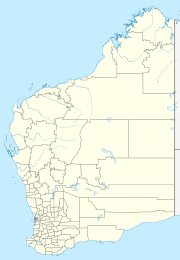Yundamindera, Western Australia facts for kids
Quick facts for kids YundaminderaWestern Australia |
|
|---|---|
| Established | 1901 |
| Postcode(s) | 6435 |
| Elevation | 448 m (1,470 ft) |
| Location | |
| LGA(s) | Shire of Leonora |
| State electorate(s) | Kalgoorlie |
| Federal Division(s) | O'Connor |
Yundamindera, also known as The Granites, is an abandoned town in Western Australia. It is located between the towns of Leonora and Laverton. The town is part of the Shire of Leonora.
Yundamindera is surrounded by large pastoral stations. These stations are mostly used for raising sheep. Some of the well-known stations include Yundamindera Station, Mount Remarkable Station, and Mount Celia Station.
Contents
History of Yundamindera
Gold Discovery and Town Founding
Gold was first found in the Yundamindera area in late 1897. This happened after the nearby Pennyweight Point goldfield started to run out of gold. Two prospectors, Wood and his nephew Deimal, found gold near a place called The Granites.
Soon, many prospectors and miners came to the area. Because so many people arrived, it became clear that a town was needed. In 1901, the townsite was officially recognized by the government. The goldfield warden suggested the name Yundamindera. He said it was the Aboriginal name for the area. The exact meaning of the name is not known.
Early Mines and Services
Several mines were started in 1899. These included the Great Bonaparte, the Queen of the May, and the Golden Treasure South. The town got its water from nearby wells and soaks.
By 1903, a coach service ran twice a week to Murrin Murrin. In 1908, a coach service also connected the town to Coolgardie and Menzies once a week.
A branch of the Western Australian Bank opened in Yundamindera in 1901. A local health committee was also set up that same year.
Education and Geology
By January 1903, local leaders wanted a teacher for the town. They talked with the Education Department. They noted that there were "a good number of children" ready for school. Sara Ramsden was appointed as the teacher in September that year.
Gibb Maitland, a government geologist, studied the area in 1903. He looked at the land between Yundamindera and Edjudina. Later, he wrote a report about the different minerals found in the goldfields.
Mining Operations and Challenges
A government-supported battery was built near the town in 1903. A battery is a machine that crushes ore to get gold out. This battery was still working in 1919. It crushed ore for most of the mines in the area.
In 1904, over 100 workers at the Potosi mine stopped working. This happened when their wages were going to be lowered. The Potosi Gold mining company then stopped the workers from coming to work. The case went to a local court. In November, the judge decided in favor of the workers.
Another gold rush happened in 1904. This was when alluvial gold was found about 30 kilometers southeast of the town. Alluvial gold is gold found in riverbeds or old streambeds. By December, over sixty men were working there and finding good amounts of gold.
In November 1905, a windmill and a large water tank were built. This helped to get water from a government well near the town. The tank could hold 100,000 imperial gallons (about 450,000 liters) of water.
The Potosi Consolidated Company mostly stopped mining in May 1907. They were having money problems. The government mill also closed around the same time. This worried local prospectors who had a lot of ore to crush. They hoped the Potosi Battery could process their ore.
A new 10-head battery was bought and set up at the Golden Treasure mine in November 1907.
Later Events and Decline
In 1910, a fire destroyed a store on the main street. The fire started early in the morning and spread quickly. The store and its goods were insured.
The area received a lot of rain, about 250 millimeters, by July 1910. This was much more than usual. This rain helped plants grow well, and cattle in the area thrived.
The Golden Treasure gold mine stopped working by April 1910. All its equipment was sold off. On its last day, it crushed 38 tons of ore and got 111 ounces (about 3.15 kilograms) of gold.
A strong rainstorm hit in November 1910. It damaged several buildings. Large hailstones, the size of pigeon eggs, fell during the storm.
In 1921, a battery from the Battlesville gold mine was moved. It was set up again at the Queen of the May mine in Yundamindera. Ore from a nearby mine was expected to be processed there.
By 1936, Yundamindera had become a ghost town. The old Granite's Hotel was being used as shearers' living quarters since 1925.
Category:Mining towns in Western AustraliaCategory:Ghost towns in Western AustraliaCategory:Shire of LeonoraCategory:1901 establishments in Australia


